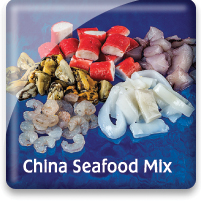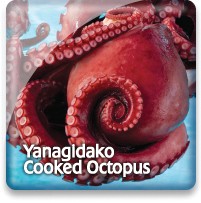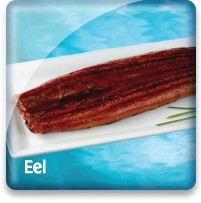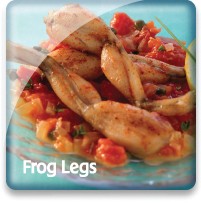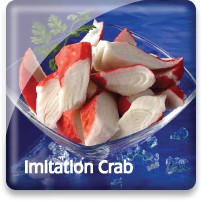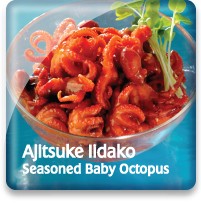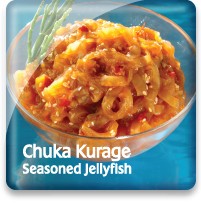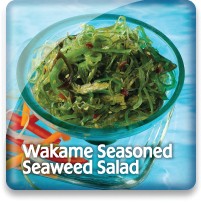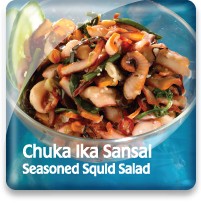
Frog Legs

Market Name: Eating QualitiesFrog Legs are mild in flavor and the meat is tender and juicy, a lot like chicken wings.
   |
Description & CharacteristicsAs a menu item, Frog Legs bring the opportunity for restaurants to present one stand-out menu item that allows chefs to showcase their creative talents. Stylish restaurants are positioning this center of the plate item on menus, giving guests a great selection with a comfortable tender and moist sea “chicken” meat.
There are more than 4,000 species of frogs.
Other Resources |
Handling Instructions for Frog Legs
Our IQF raw frog legs should be stored at or below 0°F (-18°C) and then thawed properly when ready to cook. It is best to consume frozen frog legs within 18 months of the processed freeze date. Links to further information concerning the proper handling of frog legs and other seafood: NOAA - Fish Watch: Handling Seafood and A Consumer Guide to Safe Seafood Handling.
Thawing Frog Legs
Thawing is accomplished by placing the product in a plastic container or bag and placing in the refrigerator (33 to 39°F) for 12-24 hours. Frog legs that are not consumed promptly after thawing need to be refrigerated between 33 and 39°F and totally consumed in 2-3 days.
Important Instructions for Frog Legs
Consuming frog legs immediately after proper thawing yields the best quality.
Cooking Tips
Frog legs can be prepaid just like chicken drumsticks. Links to frog leg cooking tips and recipes.
Vietnam
With a coastline of 2,140 miles, as well as numerous rivers and lakes, Vietnam has had a long tradition of fishing and a culinary tradition that includes finfish, shellfish, and molluscan shellfish.
Bordering China in the far North, and Laos and Cambodia in the middle and Southern regions, the country—known officially as the Socialist Republic of Vietnam—is divided into 58 provinces, and includes several major sea ports.
With seafood production surpassing USD $6 billion in 2012, seafood—both cultured and wild—represents an important export for this developing country.
Major seafood exports from Vietnam include cultured and wild shrimp: Black Tiger prawns and Penaeus vannamei are grown in Southeast Vietnam, and small white and pink shrimp are still commercially caught in the South China Sea off the southern coast.
In addition, Vietnam is becoming known for its high-tech seafood processing industry, adding value to commercially harvested and farmed fish and seafood.
Species that are commercially caught include Grouper, Red Snapper, Red Mullet, Tuna, Swordfish, and Barramundi—which are the major species that are exported to Australia, the United States, and the EU. Vietnam is also a major producer of farmed Tilapia, and two species of Pangisius (boucourti and hypothalamus). Squid and octopus, as well as various species of lobster and crab and molluscan shellfish are also major export products as well as products consumed in-country.
China
With more than 1.3 billion people, China is today the world’s most populous country. With a growing economy fueling an appetite for seafood, China has begun importing seafood for in-country consumption, as well as exporting a great deal of its production. In fact, since 2002, China has continued to export more fish and fishery products than any other country in the world, with Japan, the United States, and the Republic of Korea as its main export markets.
Chinese distant water fishing activities started in 1985 when China gained access to new fishing grounds through agreements with foreign countries. China operates vessels in West Africa, the North Pacific, and tuna longline vessels in the South Pacific. In addition, squid are harvested in the Japan Sea and the North Pacific under Chinese-flagged vessels.
Carp are also commercially important, as are bream, shad, eel, cat fish, rainbow trout, salmon, whitebait, mullet, mandarin fish, perch, sturgeon, murrel and pangolin. Commercial shellfish include freshwater shrimp and river crabs, molluscs such as mussels, clams and freshwater snails.
With one-fifth of the world’s population, and an official government policy to promote aquaculture, China has today become an aquaculture powerhouse, now producing more than two-thirds of the world’s aquaculture species. Fish and shellfish are grown in freshwater as well as the marine environment, including rivers, estuaries, inland lakes, ponds, and the sea.
Go Blue! Seafood Sustainability Spectrum*Click here for an explanation of our Sustainability Spectrum 
Sustainability AssessmentSea Port imports farmed North American Bullfrog legs from China and East Asian Bullfrog Legs from Vietnam. The most concerning environmental impact from North American Bullfrog aquaculture is its negative impact on other species when it is farmed as a non-native species, as in China. When escapes occur, non-native North American Bullfrogs can readily establish self-sustaining populations and outcompete many native frog populations. The East Asian Bullfrog farmed in Vietnam, where it is native, does not pose this particular type of risk. In general, all bullfrog farms can also spread disease by the release of contaminated water. Of particular concern is spread of the infectious disease chytridiomycosis, or chytrid, which is thought to be one of the primary causes of amphibian extinctions and declines worldwide. Other environmental risks associated with frog farming include local water pollution from farm waste, the use of antibiotics and other chemicals, and the use of wild fish for feed. While Sea Port is sourcing from farms that are self-contained and are free of illegal antibiotics, many additional best aquacultural practices are needed.

Environmental Impact: Moderate to HighBullfrog farming can have devastating impacts on other species by transmitting disease, particularly chytrid, and by predation and competition for resources from escaped frogs. Bullfrog farming can also cause local water pollution, introduce antibiotics and other potentially harmful chemicals into the environment, and impact wild fisheries by using wild fish for feed.
Sustainability Improvements NeededBullfrog farms should take all necessary actions to minimize the risk of spreading disease, such as preventing escapes, proactively testing for disease, disinfecting animals and farm water, implementing biosecurity measures, breeding for disease resistance, and supporting work to develop vaccines. Best management practices should also be implemented to reduce or eliminate water pollution, the use of chemicals, and the reliance on wild fish for feed.
Actions that Sea Port is UndertakingSea Port continues to evaluate and monitor the sustainability of Farmed Bullfrog Legs. Sea Port believes that bullfrog farming is heading toward more environmentally sustainable practices. Sea Port also believes that, in aggregate, choosing from a diverse variety of seafood is better for sustaining the world’s seafood resources and that frog legs can play an occasional small part in expanding the needed variety of choices.
We created the sustainability assessments for each of our seafood items in order to reveal the existing and potential environmental impacts and risks that are associated with producing them for human consumption. This allowed us to establish the starting position for each of our seafood items along our progressive Go Blue! Seafood Sustainability Spectrum®. These assessments are only a single snapshot in time and because of this, we will continue to assess and update the critical sustainability needs associated with our supply sources and issue updates to the Go Blue! Seafood Sustainability Spectrum® as needed. There is a growing global awareness for the need to assure the sustainability of farmed and wild caught seafood and because of this; all around the world positive changes are rapidly occurring at all levels of the seafood supply chain. We will continue to spread this growing awareness and work with our many industry partners to improve the sustainability of all seafood, which we believe is the ideal protein of choice to feed an ever growing world population. Our Go Blue! Seafood Sustainability Spectrum® serves as our compass and yardstick as we strive to move all our products forward to becoming more sustainable. Please join us in this committed quest and Catch Our Wave® to sustainability by choosing a diverse variety of responsibly produced seafood as part of your diet.
|


